Vol. 2, Issue 30 - Nov / Dec 2010
Posted: Tuesday 02nd November 2010
This is the first edition prepared for publication directly on the Classic Lightweights website where it can be accessed by all.
In the last edition of Lightweight News I mentioned the outbreak of Exploding Simplex gears on a recent ride for classics. Since then I’ve spent a lot of time assembling and re-assembling Tour de France gears and come across a helpful tip for re-assembly by accident.
Where the toggle chain enters the gear there is a domed nut with a hexagon nut behind it. It is possible to lock the hexagon in a vice with the operating shaft vertical. Here the juggling starts as the shaft needs to be extended in order to secure the cage on it. The inner spring and coiled cover have to go over and the rod tries to drop down again as you do this. You can ‘feed’ the toggle chain in order to get the rod extended again. Now you need to hold the threaded top (or put the nut on to get a better grip) and compress the spring and cover whilst also gripping the shaft with thin-nosed pliers. It can be done but not usually first time. You need to grip the shaft low down enough to fit the cage without it fouling the pliers.
With any luck you can now fit the cage (remembering the spring locater goes on first)and try to tighten the nut. All my attempts to do this result in the shaft turning no matter how hard it is gripped. By accident I found that compressing the cage right down , with the hexagon still in the vice, seems to lock the shaft enough to tighten the nut. A little ‘twist’ to one side on the cage may help even more. Now we have decided is the time to free the nut again (aaagh!) and apply some locking fluid.
Bob Freitas from the USA says: Always a pleasure to get your email (L N 29 – Ed). Locktite I would recommend is the ”Wicking” type (290 Green?) What’s nice about it is after tightening to spec you apply the locker. It wicks into the threads between the nut or bolt and then solidifies. Since I am on Locktite products, they have a paste /stick version of their bearing retainer which does a nice job of fixing loose head cups. Apply to the outside of the head cup flange and twist into the frame (this spreads the paste evenly between the frame and cup). Easy to remove and very durable on the road.
I was recently following a thread on a mailing list where owners of factory produced ‘sports’ bikes were extolling their virtues. My experience of the club scene in the late 40’s / early 50’s was that newcomers to club cycling would join with such a machine, often bought by parents as a reward for passing the 11+ exam, or bought with money earned doing paper rounds or Saturday jobs (see Reminiscences on the website) before the owners then decided to join a club. There was no pressure put on them by the members, but in no time the mudguards were off, one brake removed and the gear replaced by a fixed wheel.
Maybe this was just to be ‘one of the boys’ but it happened almost without fail. Perhaps some of the parts would be upgraded along the way and eventually the frame would be replaced by a craftsman-built new or second-hand frame. By now the owner would feel themselves to be ‘Gen’ and not a Tuggo. Tuggo was a derogatory term used for riders of mass-produced machines and was the opposite to ‘Gen’. Tuggos would also probably just ride around town all day trying to impress the girls (I don’t ever recall a Tuggo girl!).
I don’t wish to get involved in the debate but merely to recall what I found back then. I can see that the machines need conserving just as much as the more revered classic bikes. Perhaps I should point out that I was riding with mainly racing-based clubs and not with CTC touring type clubs where I am sure they had their own little foibles! In the modern-day scene the situation has been completely reversed as virtually everyone is riding a bike produced by a large manufacturer such as Specialized, Trek, Giant or some of the Italian producers such as Colnago (guilty me lud) Pinarello, etc. Specialized must have been pleased to have the first two riders, from different teams, in the 2010 Tour de France on their machines. I imagine that amongst contemporary time-triallists the Specialized carbon Transition time trial machine would be very high on their wish list.
Prizes: In cycling just before and after WWII there seemed to be two distinct worlds for cyclists as far as prizes were concerned. On the one hand at some of the track meetings held on both grass and hard tracks the prizes could consist of a silver or even a gold cup in some rare cases. The Muratti Vase for example was solid gold and was sponsored by a well-known cigarette manufacturer (!), another was the Vi-Tonica Gold Cup. Dunlop also presented valuable trophies. A successful track rider could win one of these outright should he be the victor for three years. It was known for top sprinters to turn down offers to compete in the Olympic Games, World Championships and the like when they were in a position of holding two ‘stakes’ in such a trophy. It has to be remembered that in those days travel overseas would be by boat and the total time away from the UK could add up to several weeks, wiping out a fair part of a season.
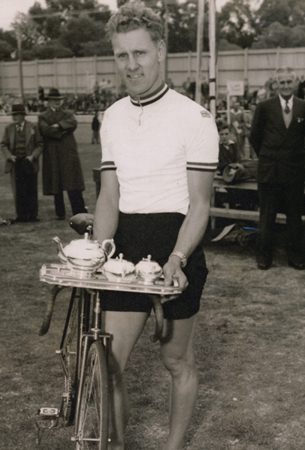
Time-triallists might be presented with a voucher for cycle parts awarded by a local shop, but the amounts were derisory. Track and road race organisers would need many more prizes and often resorted to trawling round the local shops in the search for suitable items. Some with a bit more money would present prizes bought at a discount that often consisted of items such as a mantelpiece clock, canteen of cutlery and other domestic items. The chiming mantelpiece clock was a must for most homes in those days as the only other timepieces (apart from the odd grandfather clock for the better off) was occasionally a pocket watch only used on Sundays – unless you were a railway guard. The homes of some cyclists must have been resplendent with clocks all over the house and never short of a knife and fork. Houses often had a ‘front room’ which was never used except for funerals and christenings – I know that this sounds like an exaggeration but I lived with my grandparents for four years and never saw anyone go into this room which had all the best furniture in it. It was mysteriously clean so I guess someone must have whisked a duster around it from time to time and gone in to wind up the grandfather clock in the corner.
In some cultures today there is a modern-day version of this phenomenon where furniture is purchased with transparent plastic wrappers, carefully protected by loose plastic covers over these and more plastic sheeting over the carpet. This subject is food for many a stand-up comic act.
At the other end of the spectrum the stakes were much lower. The rules of amateurism were very strict and the merest suggestion of a cash prize would result in at the very least a year’s suspension and probably much more. (Please don’t ask who those riders were with improbable names racing for cash in the Scottish Highland Games!).
But back to the prizes and the organiser’s trawl around the local shops with begging bowl. Some retailers would have the interest of the sport at heart and generously give a reasonable prize, some on the other hand got fed up with all this hassle and scoured the shop looking for some item that hadn’t sold for years and most likely would never sell. The results of this could often lead to the prize presentation looking worse than a seaside bingo hall during the Depression.
The lucky few might get the prize of a joint of meat or string of sausages from the butchers – the ration for a family of four say for one week in the post-war years would consist of a very small joint of meat about the size of a couple of chops, that would provide a couple of hot slices each for Sunday, a couple of slices cold on Monday and the rest minced into a Shepherd’s Pie on Tuesday. I often see people in restaurants these days with more meat on their plates for one person than the family would have had for three in Austerity Britain (a fascinating 700-page book by David Kynaston on the subject).
At local grass-tracks held in rural areas a farmer might donate a bag of potatoes or a runt from the litter of pigs that would surely die if left to fend for itself. This was fine except for the fact that most of the competitors cycled to the events with the sprint wheels on sprint wheel carriers.
I was told the following tale by Dick Hampton which I have published before but think it is worth repeating:
“My father used be a successful grass-track racer, he was a farmer with a small-holding and used to keep pigs. He kept up his stock by winning them at village sports/cycle meetings. At many meetings the first prize in the main race was a young pig given by a local farmer. The farmer would of course pick the smallest of the litter, namely the runt. At the end of the meet we would head for home on the track bikes (with a single brake fitted for the journey). In those days there were only brown-paper carrier bags, no plastic of course, and the pig would be stood in one of these hanging by the handles from the handlebars. Its two front feet and head would be poking over the top of the bag.
All was well for the first part of the journey until the pig got over-excited, probably speeding down a hill with father pedalling like mad on the fixed-wheel. The excitement would be too much for the pig’s bladder control and in no time the bottom of the bag was soaked and the first of the hind legs would shoot through the bottom of the bag. The race was then on to get home before the bottom of the bag gave way and the pig would land on the road and head off as fast as its (soaked) legs would carry it, chased by the family who would have to take turns carrying the pig home under one arm whilst riding on fixed. When we got home the pig would be carefully fed by hand until it was big enough to fend for itself.”
Pedal washers – I’m sure you have come across different thread lengths on pedals, some shorter that the others. The short ones hark back to the days of slender steel cranks and are designed to fit snugly in the crank with no extra thread showing. With the advent of alloy cranks, which needed to be thicker to make up for the lack of stiffness and strength, pedal threads were made longer to suit.
Two factors arise here: Using short threads in alloy cranks can allow the pedal to ‘rock’ a little inside the crank and gradually strip the threads. If they give way when riding the bike this can be disastrous, resulting in a nasty crash or painful injury at least when the pedal parts from the crank under pressure. A minor outcome is that you are left with a crank with stripped threads.
Conversely, using long threads in narrow steel cranks can create problems of their own. It is possible for the extended thread inside the right-hand crank to catch the chain as you pedal round but even if this doesn’t happen it still looks all wrong. One answer is to use washers between the pedal and the crank. TA make pedal-specific washers but their prime purpose is to protect the expensive TA cranks from damage when the pedal is tightened. As a result they are very thin – not much more that shim-like – and it needs quite a few each side to solve the problem. TA pedal washers are not cheap!
I have managed to use spark-plug washers to do this job but they are designed to compress. I have some very similar looking spring washers that are just the right thickness – I used to think that they were for spark plugs but I have my doubts as I guess gases under pressure could leak through the gap even when tightened into a cylinder block. As I have just used my last pair I need to work out where they came from. Fitting can be fiddly as the gap needs to be opposite the wide part of the pedal shoulder, not opposite the spanner flats. This should be easy except that they tend to turn when tightened and you may have to take this into account when setting it up.
In October we went to the Cycle Show at Earl’s Court on a day when we could have been out on the bikes so that is devotion to the cause. However, the trip was well worthwhile as all the major companies were there, especially those selling the classic Italian makes such as Bianchi, Colnago, Pinarello and De Rosa and the new boy on the block, Cippolini.
It is always a pleasure to drool over their offerings which drip with Italian style and charisma. What was interesting was how far up the ladder the ‘fixie’ movement has progressed as many had slightly retro, fixed-wheel machines shown prominently on their stands and taking equal placing with the new season’s offerings for the roadie (and in some cases, the track man). Many of these machines seemed to be priced around the £750 mark and were very pleasing on the eye, especially for those who like an Italian name on their bike. I have three, a modern Colnago carbon road bike plus, at the other end of the scale, a 1950/51 Frejus Supercorsa built as a replica Tour de France machine with Simplex gears, etc and a 1957/8 Cinelli Corsa with gearing by Campag. All three ride beautifully and give a great feeling of confidence at speed. I guess virtually all Italian machines are built with road-racing in mind whereas historically a lot of feedback in the UK was time-trial orientated.
It was pleasing to see that London builders Condor were holding their own with the continentals as their stand had a display of equally stylish road bikes along with their own show of retro fixies. The fixies included a mouth watering special version of the Paris Tour de France with wood sprints and South of France style bars. They had another range of ‘fixies’ created to celebrate the founder, Monty Young’s 80th birthday in this anniversary of Condor’s 60 years of trading. During this time Condor have been associated with many of the top frame builders including Bill Hurlow and Vic Braysher and have always kept abreast of what is cool in the cycling world, having supplied bikes to many famous owners including Mick Jagger. It was interesting to note that about a third of bikes on the Condor stand were fixed-wheel.
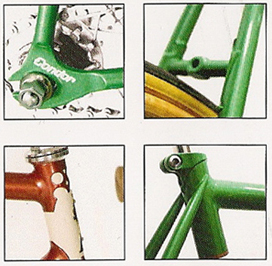
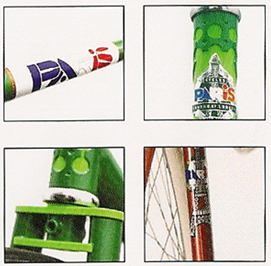
The Condor Years- A Panorama of British Cycling was published a few years ago and gave a fascinating insight into the company’s history while broadening out to cover the history of cycle racing in the UK over this period. I believe it is now out of print but is well worth tracking down amongst used books offered for sale. Author and publisher is Peter Whitfield.
I tend to think of the new wave of fixed-wheel bikes I see daily on the streets of Cambridge as ‘Retro Fixed’, that is they have many up-to-date features of their own but hark back to the period late forties/fifties when fixed wheel was very prominent in the UK at least. They range from a bog standard Raleigh or Peugeot say, hand-painted and the inner ring removed from a double chainwheel, to a completely customised machine with a selection of components carefully selected to match the owner’s vision of his very own unique machine. There is a new wave of frames, many imported, built up with custom wheels, tyres, chainrings (even matching chain colours), bars and stems and brakes.
I had a pair of wheels hanging up in the garage for several years. They were 26” Conloy Asp rims on Baylis Wiley D/F large flange hubs and built with 15/17 gauge spokes tied and soldered (nerds corner if you want to bail out!). I also had an early Hobbs Raceweight which was built for 26” wheels and I have built it twice with various gears – hub and derailleur but it never looked or felt quite right. A few days ago I took the plunge and rebuilt it with the fixed wheels and suddenly it looks and feels right at last. Had some complimentary remarks when I uploaded it to Readers’ Bikes on the website – one from Australia! It has all the right components including a nice BSA 5-pin chainset, GB alloy spearpoint stem with GB (ferruled) Maes bars and Brooks Swallow saddle.
\I also had a rather tatty Higgins Ultralight frame which was just a bit too small for me to ride as a restored frame of the 50’s. I also had several items around the garage that were not being used so I decided to give the frame a spray of white with an aerosol can and then build it up as one of the new generation type ‘fixies’. Being a welded frame this one also had that very light responsive feel which I associate with this genre. I have taken it to pose around Cambridge with all the young bloods. If anything will stop this craze in its tracks then it will be the sight of an aged pensioner muscling into the posing ranks on his lunchtime shopping trip.
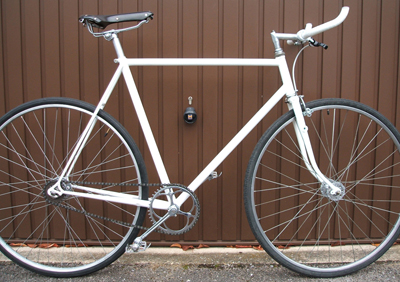
Suntour gears : by Steve Griffith
I suspect many LN readers are using Suntour gears. Their slant-parallelogram patent gave superior changing in the pre-index era and their long arm mechs were the more reliable way to get lower gears . I know the higher range Superbe and Cyclone models are often sought after but some of the cheaper models especially the ones part made with steel offer a better performance and also look more period. I particularly rate the AR and Seven models , steel front mechs do work better than alloy in my book, a fact I put down to the more rigid side plates. The only design weakness with Suntour is that the chain tension spring seems prone to breaking especially if the mech is stretched to capacity. I wonder if other users have experienced this problem?
The Spring Classics: Cycling’s Greatest One-Day Races
Velo Press, 2010
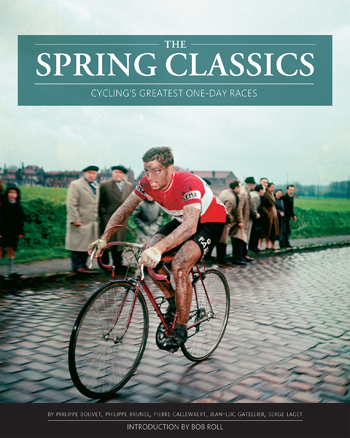
For the public at large cycle racing means the Tour de France and perhaps the major track events but for real aficionados and the riders themselves the Spring and Autumn one-day classics hold a special place in the calendar. Each has its own history and heroes, and above all, its own character formed by the region it traverses and its spectators. Riders give their all, regardless of the cobbles, toughness of the climbs, mud, or the odd blizzard, for there is no tomorrow. It’s this total commitment which produced the one-day heroes such as Alfredo Binda, Oscar Egg, Eddy Merckx, and Oscar Freire.
Spring Classics: cycling’s greatest one-day races is a celebration of these unique events throughout their history. Superbly illustrated with photographs rarely or never seen before it captures the riders, the crowd, and the landscape, from Coppi and Bartali contesting the Flèche Wallonne to Merckx taking the Milan-San Remo for the 4th time. There are reminders of the villainous weather that plays such a huge role in the Spring and Autumn classics: a snowstorm that reduced the field from 64 to 9 riders on the 1921 Paris-Tours, the repeated mud baths of the Paris-Roubaix, the dust of Milan-San Remo. This is a hard sport and Spring Classics brings home all its pain and glory. It includes a complete list of results to 2009 to settle any arguments at the tea stop.
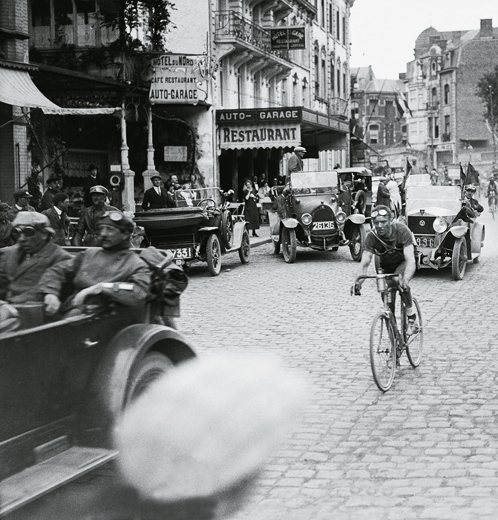
It is fascinating to study the background, of the black and white photographs in particular, as they provide a social study of life in the era they represent. It is possible to get a true idea of conditions as they were through the clothes, cars, children, etc from this source.
Photographs apart, what has kept me picking up this book time and again is the text drawn from some of the finest journalists contributing to L’Equipe, capturing the special challenges of each race, its great rides and riders. It made me wish I’d been there but the book is certainly the next best thing.
Spring Classics: cycling’s greatest one-day races is published by Velo Press, 2010, at £29.95. Available from good bookshops or direct from www.cordee.co.uk. Christmas is coming so send a letter to Santa if you’ve been a good boy (or girl)!
Odds and sods:
Eddy Ryan:- On returning from the Flying Gate weekend I foolishly lost a dust cap from a BSA rat trap pedal. The pedals having been rechromed through Trevor Jarvis. On returning to the Isle of Man I found that a dust cap was missing. They are off a 1953 Hetchins Vade Mecum that I am in the process of restoring. Would it be possible to mention this at some time in the Cambridge Newsletter please, in the hope someone might have one spare that I could have. Thank You
Eddy Ryan, Brough Jairg’ Ramsey, Isle of Man IM8 3PB
Edwin Ryan email oldblueeyes56@hotmail.co.uk
Bryan Clarke has for sale a 23″ George Brooks frame, C1957, Nervex Pro lugs, Campag ends, original condition. £85 including new set of transfers. He also has a variety of reproduction self-adhesive transfers for sale, Youngs (3 versions), Grandini, George Brooks and NOW Walvale.
Contact Bryan Clarke clarkesharman@aol.com
Steve Griffith wants a Campag seat pin allen-key fitting (but not an aero design) 27.2. Also a left -hand 170 Williams C1200 thin crank. steve.y.griffith@royalmail.com
Posted: Tuesday 02nd November 2010
This article appears in the following categories.
Upcoming Events
Whether you are looking for a gentle social meet up, or a 100-mile ride browse the community’s upcoming events and plan your next weekend outing.
